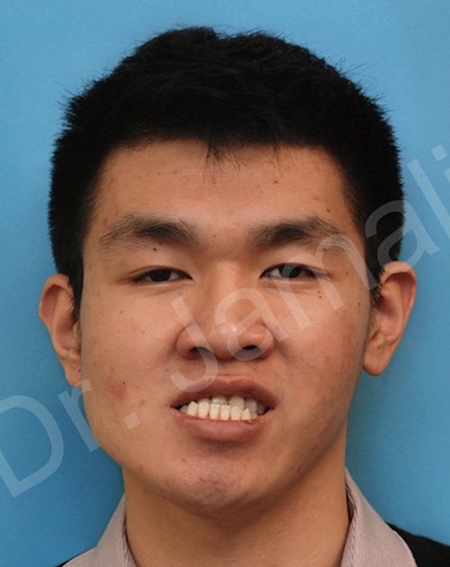What Is A Crooked Chin?
Crooked chin, also referred to as a misaligned, deformed, or asymmetrical chin, describes a condition in which the chin is deformed or is not lined up with the midline of the face. This may but not always, cause pain, difficulty chewing or speaking, and insecurity about one’s appearance.
What Are The Causes Of A Misaligned Chin?
A crooked chin is often caused by a jaw-related issue, rather than anything wrong with the chin itself. It can be caused by trauma such as a broken or dislocated jaw that has not healed correctly. Temporomandibular joint disorders (TMJ) – dysfunction of the joint connecting the jaw to the skull – can also cause misalignment of the upper and lower jaws. Condylar hyperplasia, in which the mandible is unnaturally enlarged, is one of the most common causes of a misaligned chin.
What Are The Signs And Symptoms Of An Asymmetrical Chin?

In a straight-on photo of your face, draw a straight line from between your eyes down to the philtrum of your upper lip. Your chin is misaligned if its center does not fall on this line.
What Are The Risk Factors Of A Deformed Chin?
There are a number of reasons why your chin might be crooked. You could have been born that way, or it can also result from trauma, particularly at an early age. People with arthritis are at a higher risk of TMJ disorders that could cause misalignment.
How Is A Crooked Chin Diagnosed?
In general, patients can diagnose themselves by taking selfies or looking in the mirror. However, the most reliable way to measure the degree of deformity is by taking an AP cephalogram, a panoramic x-ray, and a lateral cephalogram, as well as thorough clinical evaluation by an experienced clinician who focuses on dentofacial deformities.
What Are The Possible Treatments For A Misaligned Chin?
Dr. Jamali is experienced in performing sliding genioplasty, a surgical procedure to reshape the chin. Many surgeons prefer to use a chin implant, but Dr. Jamali believes that sliding genioplasty, in which the jawline is physically cut or shaved down, is a preferable operation because it is less invasive and has fewer potential complications.
Related Conditions To A Crooked Chin?
Other common types of facial asymmetry include cant of the mandible or maxillary plane, asymmetrical or crooked smile, or asymmetrical appearance of teeth and gums.
